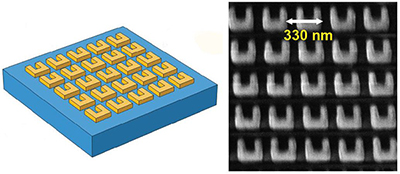
See also the layperson's introduction: Jumping frogs, squeaking bats and tapping woodpeckers and Watching ripples on crystals.
In collaboration with coworkers in Australia, we have measured the ultrafast interaction of light with a vibrating optical metamaterial based on an array of tiny gold tuning forks, known as split-ring resonators. Optical metamaterials can show counterintuitive properties such as negative refractive index, and are potentially important in applications such as cloaking and imaging.
The sample is made up of tiny gold U-shaped elements of nanoscale dimensions on a glass substrate, as shown in the figure below.

Left: schematic diagram of the sample. Right: optical microscope image of the sample. The U-shaped gold elements, that look like tuning forks, are only 60 nm thick.
When we hit them with a laser pulse, they vibrate at frequencies of several gigahertz (=109 cycles/s).

Simulation of the first three gigahertz resonances of a single element in the array.
We shine polarized light pulses onto the sample and record their reflected intensity as time passes. By analysing the ultrashort-timescale oscillations in the reflected light intensity for
different polarizations of light, we can understand the mechanisms for these oscillations. We find that the confinement of the light inside the tuning fork prongs (known as a plasmonic confinement) enhances the oscillations. Applications include ultrafast optical modulators. Full details can be found in
'Gigahertz Optomechanical Modulation by Split-Ring-Resonator Nanophotonic Meta-Atom Arrays,' Y. Imade et al., Nano Letters 17, 6684 (2017).